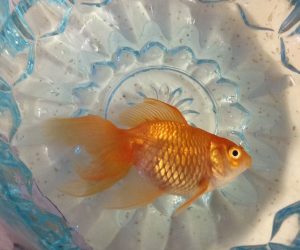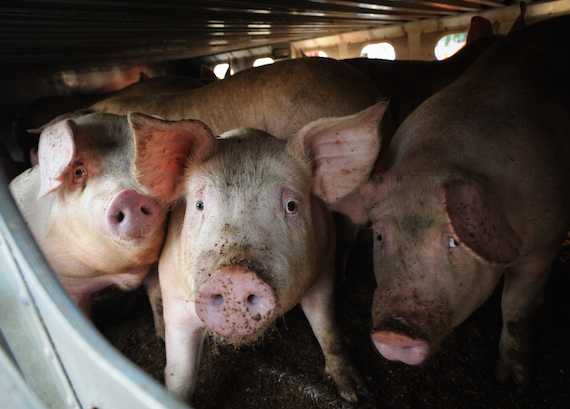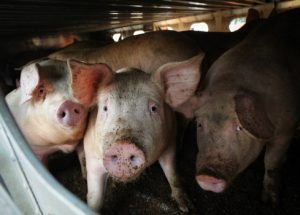
https://youtube.com/watch?v=SeYhE-BsWsY
Ce jour-ci, partout au monde – Paris, Bruxelles, Berlin, Londres, Istanbul, Delhi, Los Angeles, Toronto, Montréal –nous sommes réunis pour revendiquer la fermeture des abattoirs.
Mais les abattoirs ne se fermeront pas de leur propre gré.
Pour faire fermer les abattoirs il faut d’abord faire ouvrir les yeux et les cœurs des gens.
L’ouverture des cœurs est le seul espoir pour les indénombrables victimes innocentes, impuissantes, sans voix, sans droits, qui souffrent horriblement et inutilement, partout au monde, tous les jours, à tout moment.
Comment ouvrir le cœur des gens?
Avec deux faits fondamentaux que la plupart des gens ne savent ou ne croient pas.
I. Le premier fait fondamental est que manger de la viande n’est nécessaire pour ni la survie ni pour la santé humaine.
http://www.vrg.org/nutrition/2009_ADA_position_paper.pdf
Combien de personnes présentes ici à cette marche sont des végétaliens ou des végétariens? (Svp lever la main.)
Voilà, vous êtes la preuve vivante de ce premier fait fondamental.
II. Le deuxième fait fondamental est que, pour fournir cette viande qui n’est pas nécessaire à la survie et à la santé des 7,5 milliards d’êtres humains sur la planète, une quantité inimaginable de souffrance est nécessaire de la part de plus de 150 milliards de victimes innocentes, sans défense, sans voix, chaque année. http://www.unjoursansviande.be/compteurdelamort.html
L’abattage pour nous fournir en viande n’est pas l’euthanasie. Il ne s’agit pas de la terminaison d’une longue vie heureuse, sans terreur, sans douleur, afin d’épargner de la souffrance à la victime d’une terrible maladie incurable ou d’une douleur insupportable.
L’abbatage est la terminaison terrifiante et terriblement douloureuse d’une vie courte et pleine de maladies et de douleurs, de la part de victimes innocentes qui ont été engendrées et élevées exprès pour être impitoyablement abattues. http://j.mp/images-abattoirs
Et tout ça sans aucune nécessité pour notre survie ou notre santé. Nous ne leur faisons toutes ces horreurs que pour le plaisir de nos palais, et par habitude.
Les manifestations comme celle d’aujourd’hui sont très importantes, mais elles ne suffisent pas pour ouvrir le cœur des gens et pour fermer les abattoirs.
Pour cela, nous devons d’abord ouvrir les abattoirs, avec des Webcam de surveillance audiovisuelles, placées à tous les sites des abominations – caméras qui filmeront les horreurs et les transmettront toutes, immédiatement, de façon continue et permanente, sur le Web. Comme ça tout les citoyens peuvent devenir témoin du coût terrible en termes d’agonie qu’infligent nos préférences gustatives, à chaque instant de chaque jour, partout, aux êtres sensibles, innocents, sans défense, sans droits, sans voix, sans répit, sans secours.
Mon cher ami Stevan, je viens de tomber, en faisant ma recherche bibliographique mensuelle, sur un article du…
Posted by Jean-Jacques Kona-Boun on Monday, 15 June 2015
Ce n’est pas tout le monde qui regardera ces vidéos sur le Web.
Mais le nombre de témoins qui regarderont, verront et ainsi sauront la vérité déchirante par ce moyen augmentera de plus en plus le nombre de ceux qui le savent aujourd’hui, à un moment où la vérité reste toujours hermétiquement cachée de nos yeux et de nos cœurs. https://en.wikipedia.org/wiki/Ag-gag
Et ceux d’entre nous qui connaitrons cette vérité pourrons fournir la voix aux victimes.
Les réglementations existantes pour minimiser la souffrance dans les abattoirs sont honteusement insuffisantes : Comment peut-on mettre fin à une vie innocente, sans nécessité, de manière humanitaire?
Mais même les réglementations inadéquates qui existent aujourd’hui ne sont ni appliquées ni surveillées ni contrôlées adéquatement.
La surveillance publique des abattoirs, basée sur les preuves diffusées sur le Web, témoignées et rapportées par un nombre croissant de citoyens militant pour la protection des animaux fera en sorte que déjà les réglementations inadéquates d’aujourd’hui – ainsi que les poursuites pour leur violation – seront mises en vigueur beaucoup plus rigoureusement.
Nous venons d’acquérir un principe de base juridique pour revendiquer une surveillance rigoureuse des abattoirs: La semaine dernière, l’Assemblée nationale du Québec, la province qui fut jusqu’ici la pire au Canada pour la protection des animaux, a tenu compte des nombreuses voix Québecoises soulevées au nom des animaux. http://lesanimauxnesontpasdeschoses.ca
Le Code civile du Québec vient d’être modifié pour accorder aux animaux le statut d’êtres sensibles au lieu du statut de propriété inerte – ou biens meubles — comme anciennement. http://www.assnat.qc.ca/fr/travaux-parlementaires/assemblee-nationale/41-1/journal-debats/20150605/148869.html#10h
Mais cette nouvelle loi, comme cette manifestation, ne suffit pas.
Sur cette nouvelle base juridique, et à l’aide des preuves audiovisuelles, témoignées par toute la citoyenneté québécoise, nous pourrons non seulement poursuivre ceux qui ne respectent pas les réglementations actuelles, inadéquates, mais nous pourrons aussi exiger l’adoption des lois de plus en plus fortes pour protéger les êtres sensibles.
Les preuves transmises par ces Webcams de surveillance serviront aussi à sensibiliser tous les citoyens concernant les horreurs nécessitées par une diète non-végane.
Il s’agira de la sensibilisation à la sensibilité des êtres sensibles.
Et c’est les preuves incontournables des souffrances de ces victimes sensibles — et de l’inutilité de leurs souffrances — qui risquent à nous inspirer tous à ne plus demeurer non-véganes — sans aucune nécessité vitale, juste pour le plaisir gustatif — à ces terribles frais.
Permettez-moi de conclure avec un peu de numérologie optimiste et une ruse pyramidale la plus bénigne du monde:
Si chaque végane qui est présent ici aujourd’hui inspire encore 6 non-véganes à (1) devenir végane ainsi qu’à (2) inspirer à leur tour encore 6 non-véganes à devenir végane et ainsi de suite, alors en seulement 9 étappes toute la population du Québec sera végane, en 10 étapes tous les Canadiens, à 11 le Canada ainsi que les États-Unis, et entre 12 et 13 ça sera le monde entier.
Il faut noter également qu’il est tout à fait juste que ça soit avec nous-autres, qui sommes parmi les citoyens les plus prospères et les mieux-nourris au monde, que tout cela démarre.
Au moment où nous aurions fermé tous nos abattoirs industriels et re-dédié nos terres vers la production directe d’aliments à nourrir les gens — au lieu de les utiliser à élever, nourrir et ensuite massacrer d’innombrables victimes innocentes, inutilement — la planète produira ainsi 40% plus de nourriture, 60% moins de pollution et 90% moins de souffrance. http://www.cowspiracy.com/facts/
Ceci sera assez pour nourrir toutes les victimes de la famine ainsi qu’à permettre aux derniers chasseurs de subsistance sur la planète de faire la transition vers une consommation réellement équitable et miséricordieuse.
<center >
>
 “Marriage” (as opposed to civil contracts), and especially its overlay of fideist fanfare and flim-flam, has always struck me as silly, irrespective of what genders are involved.
“Marriage” (as opposed to civil contracts), and especially its overlay of fideist fanfare and flim-flam, has always struck me as silly, irrespective of what genders are involved.








